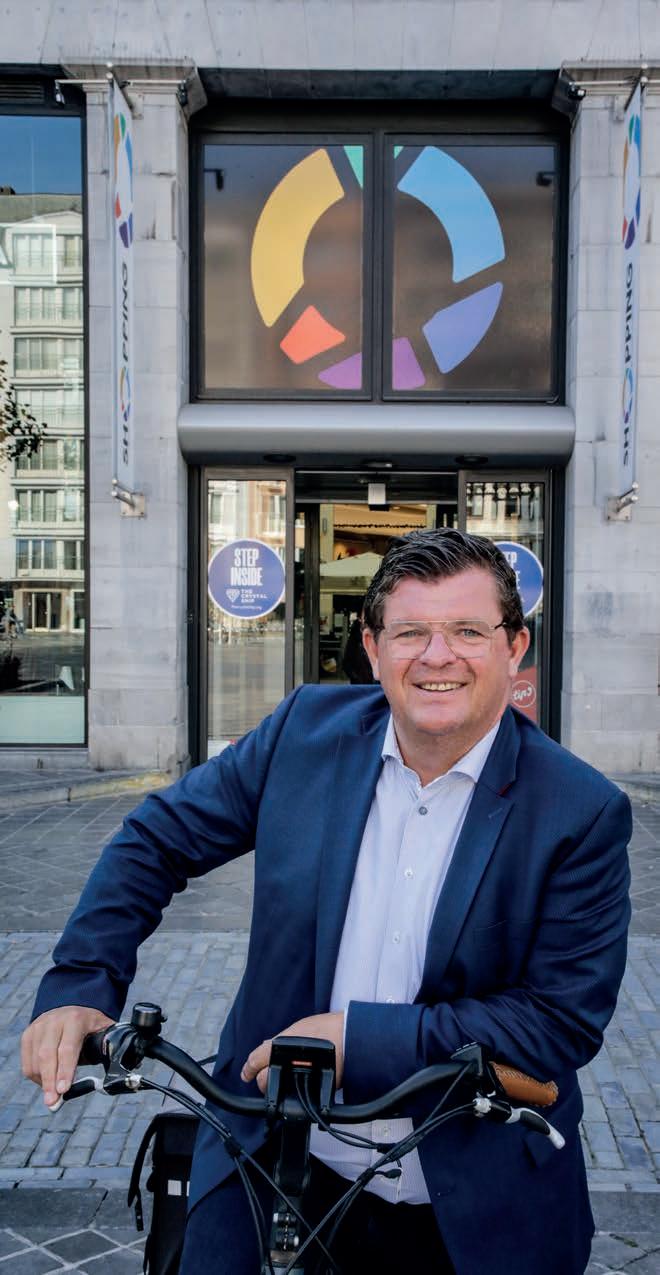
4 minute read
Mayors of Oostende & Waregem : regional cities with big plans
Regional cities with big plans

Advertisement
The heart of the city, the marketplace and the surrounding shopping streets. Mayors are doing the utmost to make their city centres appealing and are looking for solutions to respond to the challenges the retail industry is facing. With its many years of professional experience, CEUSTERS assists them, also outside shopping centres and retail parks. The real estate group joins local authorities in brainstorming about the metamorphosis of smaller city centres, where the marketing of shopping streets is concerned, for example. In addition, the collaborators of CEUSTERS are taking on an active role in retailer associations. Ostend’s Bart Tommelein and Waregem’s Kurt Vanryckeghem give us their view.
Kurt Vanryckeghem, Mayor of Waregem
As a city, Waregem has an important central function. Inhabitants of the square formed by the towns of Tielt, Deinze, Oudenaarde and Harelbeke don’t just come to Waregem to do their shopping, they also come to the library, the swimming pool, or the cultural centre here. “On top of that, many people settle down in our city centre,” says mayor Kurt Vanryckeghem. “At meetings for new inhabitants, I often find a lot of people that are older than sixty. Those are people buying a centrally located apartment here, so they can do all their shopping with a trolley.” “It’s not just quick and easy to park your car in the centre of Waregem, it’s about the size of a postal stamp. On an axis that’s only some hundred meters long, you can find all the facilities you need. We’re consciously using town planning to make the high street more compact. Within the perimeter we determined in our commercial strategic plan, we’ve made stores mandatory in new builds. The long shopping streets of olden days are a thing of the past. Thirty ladies’ boutiques and seventeen shoe stores, those days don’t come back. And yet, Waregem still boasts a nice range of retailers, but we do counter fragmentation.”
“The heart of our city is shopping centre Het Pand. In the 1970s it was a huge, trailblazing project. Now its age is showing, in both the building itself and the shops on oer. For the renovation and to upgrade the oer, we’re calling on CEUSTERS. We’re opting for a professional partner because our relationship with the retailers is too intense
for us to be negotiating with them ourselves, to be changing the terms of contracts, to be discussing moves, etc. CEUSTERS’s collaborators aren’t just taking care of how the premises are decorated, but also of who occupies them. Temping agencies or showrooms don’t belong there, but high-appeal perfume stores or clothing brands do.”
The renovation of Het Pand—fully owned by the city through the autonomous municipal corporation— is a long-range plan requiring a 20-million-euro investment. “We’re not just tackling the shopping centre itself, but the entire surrounding area as well. We’ve already built an underground parking garage for 400 cars. We’re continuing to manage all these things ourselves, so the municipal authorities can act as regulator. There’s barely any opposition to this. On the contrary, local tradespeople are happy to see Het Pand being updated. We hope this will inspire shopkeepers in the surrounding streets to renovate and create added value, too.”
Bart Tommelein, Mayor of Ostend
“O stend is the only city by the Belgian seaside. Our shops don’t just appeal to visitors from neighbouring towns and municipalities— second-home owners also come here to shop on weekends. Economically speaking, tourism is the driving force behind our city. We attract overnighters and day-trippers to Ostend with numerous events. Cleverly targeted marketing campaigns help us put Ostend on the map. The cooperation between the Ostend tourist office and central management, who organized innovative shopping events together, is also a cornerstone.”
'We're further boosting occupancy rates'

“The centre of Ostend is in a tourist zone, which means shops can also open on Sundays. Our commercial centre is right by the beach. Many shoppers combine di erent things: they go walking before or after shopping, they go for a meal, they go and see the football, or they visit an exhibition. Roadworks are an important challenge. We try to limit the inconvenience for retailers and shoppers. At the same time, we’re working on a new, smart parking plan, ensuring visitors drive as little as possible in the city centre. With a shuttle, for example, they should be able to get to the low-tra ic streets easily.”
“E-commerce and other novelties are on the up-and-up. In Ostend, we choose to focus on innovation and experience. Among others, our centre manager ensures a good mix between large chains and original boutiques. Visitors need a reason to come to our shopping centre. And why shouldn’t they discover new things here and have them delivered to their homes?”
“These past few years, our retail associations have professionalized and set up two non-profit organizations. Our retail community was asking for a fixed point of contact, collective actions, and promotions. They got those thanks to our centre manager and coordinator. In Ostend, we can boast decreasing vacancy rates, as opposed to similar cities. A business development manager is actively trying to convince retailers to open here. The Ostend tourism o ices help to build the image of a city where there’s always something to do. Even though we notice demand is highest for larger premises. If necessary, I’ll sit down with real estate operators for this opportunity, in all transparency.”




